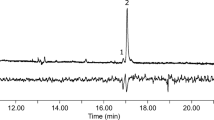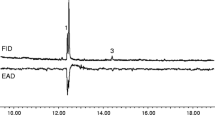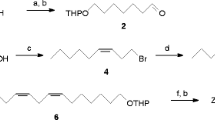Abstract
The sex pheromones of three Cryptophlebia, one Centroxena, and one Eucosma species (Lepidoptera: Olethreutinae) inhabiting mangroves in the Ryukyu Islands, Japan, were studied with coupled gas chromatography-electroantennographic detection, and GC-mass spectrometry (GC-MS). The larvae of each Cryptophlebia species are specifically associated with viviparous seedlings from one of three mangrove Rhizophoraceae plants. Whereas three EAG-active alcohol components, (Z)-8-dodecen-1-ol, (E)-8-dodecen-1-ol, and dodecan-1-ol, in a ratio of 100:12:4, were identified from the pheromone gland extract of female of C. horii (host: Bruguiera gymnorrhiza), two other sibling species produced the corresponding acetates, i.e., (Z)-8-dodecenyl acetate, (E)-8-dodecenyl acetate, and dodecyl acetate, in a 100:2:3 ratio from Cryptophlebia palustris (host: Rhizophora stylosa in Iriomote-jima Island) and in a 100:7:13 ratio from C. amamiana (host: Kandelia candel in Amami-oshima Island). The double bond positions of the monounsaturated components were confirmed by GC-MS analyses of their adducts with dimethyl disulfide. On the other hand, the larvae of Centroxena sp. feed on fruits of Sonneratia alba, another mangrove plant in the Sonneratiaceae, and the extract of the female pheromone glands contained (8E,10E)-dodecadienyl acetate and dodecyl acetate in a ratio of 100:5. The double bond position of the diunsaturated compound was confirmed by GC-MS analysis of its adduct with 4-methyl-1,2,4-triazoline-3,5-dione. (E)-9-Dodecenyl acetate was exclusively identified in the pheromone gland extract of Eucosma coniogramma females reared from seedlings of B. gymnorrhiza. Although the roles of minor components have not been revealed by field tests, synthetic lures baited with the main pheromone component of each species successfully attracted the target males, confirming that the sex pheromone is one of the most important factors for their reproductive isolation.






Similar content being viewed by others
References
Ando, T. 2005. Internet database: http://www.tuat.ac.jp/~antetsu/LepiPheroList.htm
T. Ando Y. Kurotsu M. Kaiya M. Uchiyama (1985) ArticleTitleSystematic syntheses and characterization of dodecadien-1-ols with conjugated double bond, lepidopterous sex pheromones Agric. Biol. Chem. 49 141–148 Occurrence Handle1:CAS:528:DyaL2MXksFersLY%3D
T. Ando S. Inomata M. Yamamoto (2004) ArticleTitleLepidopteran sex pheromones Top. Curr. Chem. 239 51–96 Occurrence Handle1:CAS:528:DC%2BD2MXhs1ansg%3D%3D
H. Arn M. Töth E. Priesner (1997) ArticleTitleList of sex pheromones of Lepidoptera and related attractants, supplement 1992–1996 Technol. Trans. Mating Disrup. 20 257–293
H.-R. Buser H. Arn P. Guerin S. Rauscher (1983) ArticleTitleDetermination of double bond position in mono-unsaturated acetates by mass spectrometry of dimethyl disulfide adducts Anal. Chem. 55 818–822 Occurrence Handle10.1021/ac00257a003 Occurrence Handle1:CAS:528:DyaL3sXhs1Shs70%3D
El-Sayed, A. M. 2005. Internet database: http://www.pherobase.com/
T. V. Hai L. V. Vang P. K. Son S. Inomata T. Ando (2002) ArticleTitleSex attractants for moths of Vietnam: Field attraction by synthetic lures baited with known lepidopteran pheromones J. Chem. Ecol. 28 1473–1481 Occurrence Handle10.1023/A:1016208921583 Occurrence Handle1:CAS:528:DC%2BD38XmsVOhsLY%3D Occurrence Handle12199508
D. R. Hall P. S. Beevor A. Cork B. F. Nesbitt E. A. S. La Croix (1984) ArticleTitle(Z)-8-Dodecenyl acetate: The major component of the female sex pheromone of Cryptophlebia batrachopa, a tortricid pest of macadamia in Malawi Entomol. Exp. Appl. 35 33–36 Occurrence Handle1:CAS:528:DyaL2cXkvVOltL0%3D
C. C. Hung J. S. Hwang M. D. Hung Y. P. Yen R. F. Hou (2001) ArticleTitleIsolation, identification and field tests of the sex pheromone of the carambola fruit borer, Eucosma notanthes J. Chem. Ecol. 27 1855–1866 Occurrence Handle1:CAS:528:DC%2BD3MXmtlSisb0%3D Occurrence Handle11545375
R. Ideses A. Shani (1988) ArticleTitleChemical protection of pheromones containing an internal conjugated diene system from isomerization and oxidation J. Chem. Ecol. 14 1657–1669 Occurrence Handle1:CAS:528:DyaL1cXmt1CltL0%3D
S. Inomata M. Komoda H. Watanabe M. Nomura T. Ando (2000) ArticleTitleIdentification of sex pheromones of Anadevidia peponis and Macdunnoughia confusa, and field tests of their role in reproductive isolation of closely related Plusiinae moths J. Chem. Ecol. 26 443–454 Occurrence Handle1:CAS:528:DC%2BD3cXhsVKiu78%3D
Inomata, S., Watanabe, A., Nomura, M., and Ando, T. 2005. Mating communication systems of the Plusiinae species distributed in Japan: Identification of the sex pheromones and field evaluation. J. Chem. Ecol. 31, in press.
Kinjo, M., Azuma, S., and Katada, S. 2001. Ecological findings in 3 Tortricidae species parasitic on Bruguiera gymnorrhiza (L.) Lamk. Report for the research on mangroves delegated by the Cabinet Office. Government of Japan, pp. 27–35 (in Japanese).
F. Komai (1999) ArticleTitleA taxonomic review of the genus Grapholita and allied genera (Lepidoptera: Tortricidae) in the Palaearctic region Entomol. Scand. Suppl. 55 1–226
F. Komai Y. Nasu (2003) ArticleTitleFour species of Olethreutinae (Lepidoptera: Tortricidae) associated with viviparous seedlings of the mangrove Rhizophoraceae in the Ryukyu Islands, Japan Invertebr. Syst. 17 75–87
D. L. Struble H. Arn (1984) Combined gas chromatography and electroantennogram recording of insect olfactory responses H. E. Hummel T. A. Miller (Eds) Techniques in Pheromone Research Springer-Verlag New York 161–178
E. W. Underhill C. E. Rogers L. R. Hogge (1987) ArticleTitleSex attractants for two sunflower pests, Eucosma womonana (Lepidoptera: Tortricidae) and Isophrictis similiella (Lepidoptera: Gelechiidae) Environ. Entomol. 16 463–466 Occurrence Handle1:CAS:528:DyaL2sXksFCis7g%3D
Witzgall, P., Lindblom, T., Bengtsson, M., Tóth, M. 2004. Internet database: http://www pherolist.slu.se/cgi-bin-pherolist/pherolist.cgi.
D. C. Young P. Vouros M. F. Holick (1990) ArticleTitleGas chromatography-mass spectrometry of conjugated dienes by derivatization with 4-methyl-1,2,4-triazoline-3,5-dione J. Chromatogr. 522 295–302 Occurrence Handle1:CAS:528:DyaK3MXnsVGjsA%3D%3D Occurrence Handle2081754
Acknowledgments
The authors are grateful to Drs. F. Mochizuki and T. Fukumoto, of Shin-etsu Chemical Co., Ltd. for supplying synthetic pheromones for field tests.
Author information
Authors and Affiliations
Corresponding author
Rights and permissions
About this article
Cite this article
Van Vang, L., Inomata, SI., Kinjo, M. et al. Sex Pheromones of Five Olethreutine Species (Lepidoptera: Tortricidae) Associated with the Seedlings and Fruits of Mangrove Plants in the Ryukyu Islands, Japan: Identification and Field Evaluation. J Chem Ecol 31, 859–878 (2005). https://doi.org/10.1007/s10886-005-3549-5
Received:
Accepted:
Published:
Issue Date:
DOI: https://doi.org/10.1007/s10886-005-3549-5




